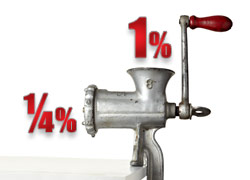U.S. stocks recovered to close flat on Wednesday due to positive economic data whilst crude oil moved higher due to a European Union agreement to ban imports of Iranian oil. The euro and European equities struggled to make gains as investors’ concerns once again returned with regards to the region’s debt crisis.
Concerns about the euro zone debt crisis dragged stocks lower in Europe after Italy’s biggest bank, UniCredit priced a 7.5 billion euro capital hike at a huge discount to engender interest. That level may discourage other lenders from tapping the market to raise money. UniCredit slumped 14.5 percent on Wednesday.
Fresh fears about the eurozone banking system were raised when record amounts of cash were deposited with the European Central Bank and Italy’s UniCredit spooked markets with a cash call on investors. €453bn was lodged in the ECB’s “deposit facility” on Tuesday night. Some analysts fear this reveals that banks are so concerned about lending cash out to rivals they’d rather earn just 0.25% in interest from the central bank whilst borrowing at 1.0%…
The ECB revealed that €15bn was used from its emergency lending facility overnight on Tuesday, following €14.8bn borrowed the previous day. It’s not immediately clear the ‘ECB deposits’ can be equated to the €498bn banks borrowed from the central bank in the tender in December for unlimited three-year loans. Banks might need to sit on the cash in anticipation of requiring funds later in the year when their current form of bond financing matures.
Crude oil futures rallied as a consequence of European governments agreeing in principle to ban imports of Iranian oil. The agreement sent oil to a seven-week high. Brent February crude hit $113.97 per barrel, its highest since November 14, before paring gains to settle 1.4 percent higher at $113.70. Europe is the second-biggest customer for Iranian crude after China, buying about 450,000 barrels out of a total of 2.6m barrels a day the country exports. Iran has shrugged off the threat, saying it can find new customers, but it will almost certainly have to sell its output at a discount to its remaining and new buyers.
The Standard & Poor’s 500 Index closed less than 0.1 percent up to 1,277.30 after losing 0.7 percent earlier. The Dow Jones Industrial Average climbed 21.04 points, or 0.2 percent, to 12,418.42. Ten-year Treasury yields added six basis points to 2.01 percent before trading at 1.98 percent. The S&P GSCI Index of commodities added 0.5 percent as natural gas and heating oil rose at least 1.9 percent and crude jumped to the highest since May. The dollar climbed versus 13 of 16 major peers. Banks led European stocks lower.
The euro weakened 0.8 percent against the yen as it declined against 13 of 16 major peers. The yen strengthened against 15 of its 16 most-traded peers. The pound rose to the highest in 15 months against the euro as the cost of insuring Spanish bonds against default climbed on concern the region’s debt crisis is worsening. The pound climbed 0.9 percent to 82.65 pence per euro, the the strongest since Sept. 13, 2010, before trading at 82.79 pence at 4:07 p.m. London time. Sterling fell 0.3 percent to $1.5602 and 119.71 yen.
The pound also gained against the euro and the Swiss franc as Bank of England data showed foreign investors boosted their gilt holdings by 16.3 billion pounds in November, the biggest monthly rise since September 2008. That’s an increase from the net purchase of 12.5 billion pounds in October.
Economic calendar data releases that may affect sentiment in the morning session
Thursday 5 January
09:30 UK – PMI Services December
10:00 Eurozone – Industrial New Orders October
10:00 Eurozone – Producer Price Index November
Analysts expect industrial new orders to be +2.50% (MOM), according to a Bloomberg survey, as compared with the previous (revised) figure of -6.20%. The median expectation for the annualised change is +3.30%, against the previous figure of +1.60%. A survey of analysts compiled by Bloomberg shows a predicted month-on-month change of 0.10%, for the producer price index the same figure that was reported in last month’s release. The survey gave a median forecast of +5.20% year-on-year (the previous month’s annualised rate was +5.50%).





